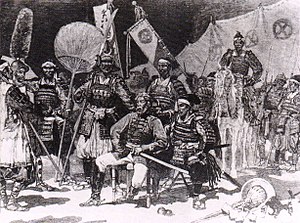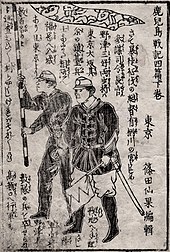Satsuma Rebellion
| Satsuma Rebellion 西南戦争 | |||||||
|---|---|---|---|---|---|---|---|
 Saigō Takamori (seated, in Western uniform), surrounded by his officers, in samurai attire. News article in Le Monde Illustré, 1877. | |||||||
| |||||||
| Belligerents | |||||||
| Imperial Japanese Army | Satsuma fief | ||||||
| Commanders and leaders | |||||||
|
Ruler: Meiji Emperor CIC: Sumiyoshi Kawamura | Saigō Takamori | ||||||
| Strength | |||||||
| 300,000 | 40,000 | ||||||
| Casualties and losses | |||||||
| estimate ~60,000 dead soldiers | about 30,000 dead | ||||||
The Satsuma Rebellion (Seinan Sensō 西南戦争, 'Southwestern War') was a revolt of the Satsuma clan samurai against the Imperial Japanese Army, which occurred 11 years into the Meiji Era, in 1877.
Background
The samurai of Satsuma had grown dissatisfied with the direction the government was taking. The modernization of the country was resulting in the dismantling of feudalism, destroying the traditional social structure. Perhaps more importantly to the samurai the dismantling of feudalism also meant the abolition of their social status, privileges and power, and undermined their financial position. The rebellion was led by Saigō Takamori, who about ten years earlier had led the forces favourable to the Meiji restoration during the Boshin War, had then been a leader in the new government and who, as field marshal, had actually been responsible for forming the government army that he now opposed. Saigō had supported the reforms in the beginning. But when the privileges of his own samurai class were abandoned, his conservative and traditionalist character caused him to side with his class rather than the national government. Saigō Takamori fought for the preservation of the caste of the samurai but also a more virtuous form of government (the slogan of his rebel movement was "新政厚徳", "New government, High morality"). They did not neglect Western military methods: they used guns and cannons, and all contemporary depictions of Saigō Takamori represent him wearing the uniform of a Western general. At the end of the conflict, running out of material and ammunition, they had to fall back to close-quarter tactics and the use of swords, bows and arrows.
Combat

In January 1877, the government sent a naval unit to disarm Kagoshima, a key city in the Satsuma domain. The unit was attacked by Saigō and his men. Saigō's samurai forces fought with some modern firearms as well as traditional weapons, but his military tactics were traditional and antiquated.

In February, Saigō and his army of 25,000-40,000 men besieged the government garrison in the city of Kumamoto. The siege of Kumamoto is considered by historians a major tactical blunder on Saigō's part as it allowed time for the government to attack with 300,000 soldiers, under the command of Sumiyoshi Kawamura. The rebel samurai managed a kill ratio of two to one, but were heavily outnumbered. The battle lasted six weeks, and lowered the number of Saigō's men to 300-400. Saigō and his remaining samurai were pushed back to Kagoshima where, in a final battle, the Battle of Shiroyama, Saigō was badly injured. Saigō had one of his fellow samurai cut off his head before he could be captured on September 24, 1877.

Crushing the Satsuma Rebellion cost the government greatly financially. This rebellion was also the end of the samurai class. Saigō Takamori was labeled as a tragic hero by the people and ten years later the Japanese government pardoned and promoted him posthumously to highest honors.
In Media
The PS2 video game Way of the Samurai takes place in the Satsuma Rebellion.
The 2003 movie The Last Samurai, starring Tom Cruise and Ken Watanabe, is loosely based on the events of the Satsuma Rebellion.
Further reading
Craig, T. (1999). Remembering Aizu: The Testament of Shiba Goro. Honolulu, HI: U of Hawai'i Press. ISBN 0-8248-2157-2.
Henshall, K. (2001). A History of Japan: From Stone Age to Superpower. New York City, NY: St. Martin's Press. ISBN 0-312-23370-1
